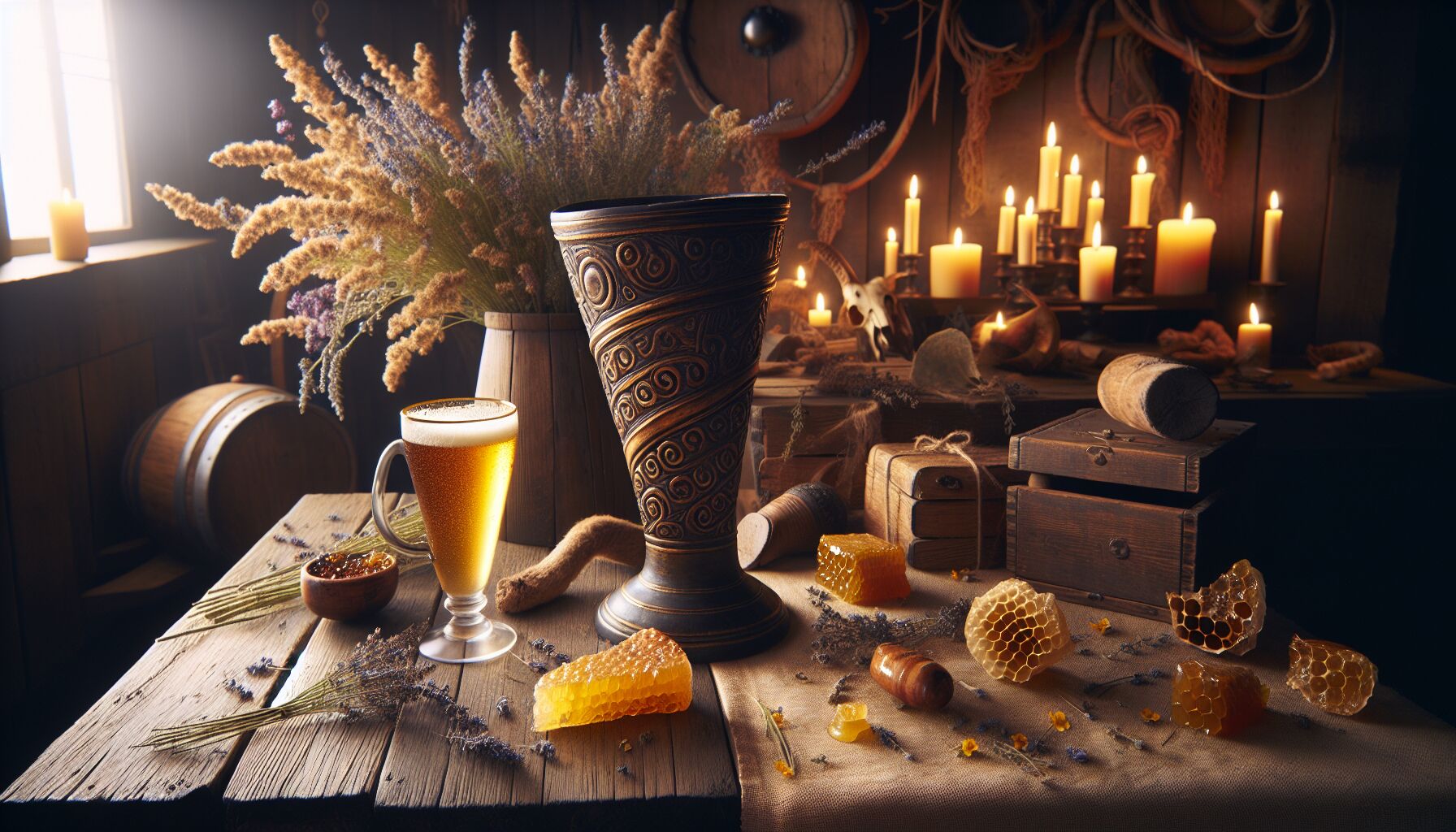 Imagine you’re trudging through a Scandinavian forest, the crisp air carrying whispers of ancient tales from a time when Vikings roamed the land. These rugged Norse warriors were not only known for their fearsome raids but also for their cunning knowledge of natural remedies. Among their treasure trove of herbal concoctions and mystical brews, there’s one that stands out—a shimmering spoonful of golden mead. It’s alluring to think about how this seemingly simple brew of fermented honey played a role beyond quenching thirst on long voyages, seeping into the very threads of Viking health and cultural fabric.
Imagine you’re trudging through a Scandinavian forest, the crisp air carrying whispers of ancient tales from a time when Vikings roamed the land. These rugged Norse warriors were not only known for their fearsome raids but also for their cunning knowledge of natural remedies. Among their treasure trove of herbal concoctions and mystical brews, there’s one that stands out—a shimmering spoonful of golden mead. It’s alluring to think about how this seemingly simple brew of fermented honey played a role beyond quenching thirst on long voyages, seeping into the very threads of Viking health and cultural fabric.
Here’s where it gets interesting: Mead wasn’t just any drink. It was a potion of life, a gift from gods, and often brewed under the stars as a spiritual ritual. Vikings didn’t merely ferment honey for its sweetness—oh no, it was the magic of fermentation that transformed this sticky substance into a powerful elixir. Much like homemade sourdough gaining flavor from its wild yeast, mead was believed to draw strength from the earth, air, and the hands that forged it. It was their answer to nature’s bounty, a bottled certainty that connected them to the cosmic dance of life, death, and renewal.
The cultural significance of mead in Viking society was immense. This wasn’t just a beverage but a symbol of unity and prosperity. Picture a grand hall where chieftains and bards gathered around roaring fires, clinking drinking horns filled with mead—a scene echoing Thor’s own celebrations! Mead was woven into the fabric of Scandinavian poetry and lore, being poured liberally during festivals or solemn rituals honoring gods like Odin. Can you envision Odin himself, seeking wisdom from his mead, which the ancient sagas suggest, was blessed by the wise goddess Freyja?
Let’s not forget how the spiritual aspect of mead intertwined with the practical. For a people at the mercy of the elements and many foes, finding strength in something as accessible as honey and water was not just genius but a bit legendary. Mead was a cornerstone providing warmth in winter and solace for weary souls. It was crafted not merely for indulgence but seemingly with intent to heal and enlighten. Intriguingly, some believed it even enhanced senses, making warriors shrewder in battle and eloquent in counsel.
Perhaps the question nudging at your consciousness is: Why does this ancient brew matter now? More than a nod to our heritage, the lessons carried in mead tell of a people deeply in tune with their environment and their souls. Like C.G. Jung once mused about our rich, untapped psyche—could we, through just a sip of forgotten wisdom, weave these stories into our own tapestry of health and community?
For those who thirst for deeper understanding, there’s more to uncover. Beyond its delightful taste, mead acts as a bridge connecting us to forgotten rituals that once synchronized our lives with the rhythm of the earth. As we stir our own honey wine today, perhaps we rekindle that same fire, warmth, and ancient unity beneath the stars. Together, let’s explore modern roles of this fabled elixir in our evolving journey towards conscious living. How does that sound for continuity of the ages?
health benefits and healing properties
They say the body is a temple, and the Vikings seemed to know a thing or two about keeping theirs in fighting shape. The art of fermentation, as they understood, wasn’t just a quirky way to preserve food or get a good buzz. Mead, that luscious liquid gold, was believed to have real health benefits that transcended its role as a ceremonial beverage.
Let’s explore something simple yet profound, shall we? Mead’s very foundation—honey—has been celebrated for millennia as a natural healer. Not just a sweet treat but a blessing, honey comes packed with antibacterial and antifungal properties. Imagine the ancient Norsemen, rugged as they were, facing off not just against the elements but also infections and ailments. Here, their mead became a natural ally. The fermentation process added layers of complexity to this already magical concoction, introducing probiotics that could soothe the gut and strengthen the immune system. It’s akin to today’s kombucha craze, though perhaps a bit more legendary.
But there’s more to the story. The potency of mead as a healer wasn’t solely chemical. Drink a horn or two during a deep Scandinavian winter—or after a skirmish—and you might just feel a warmth growing, not unlike a soft afternoon sun. The mind and body rejuvenate, entwined in a dance of mystical hydration and newfound vigor. This connection between the spirits within the brew and the spirit within us might remind one of what Hermes Trismegistus implied when he said that each of us is a universe unto ourselves.
Now, before you dismiss this as ancient hokum, consider the emerging science that supports the psychological aspect of community and shared ritual. The act of pouring and drinking mead was often communal—a healer, not just of the body but of the social fabric too. Sitting in circle, warriors and farmers alike would find solace in shared stories, perhaps easing the burdens of their world and creating bonds that no man could fracture.
How does mead fit into today’s quest for holistic wellness—and why should we care? Well, if you’re someone on the lookout for natural remedies that bridge culture and health, then mead beckons. It offers a historical precedent for healing that’s as comforting as grandma’s soup. Who knows? Maybe a humble sip can reconnect us not just with our health but with each other, as ancient as the earth beneath our feet and as new as the dawn we greet with open arms. Curious about the roots of this truth? Discover more about the health-enhancing properties of honey at NCBI, and explore how these time-tested remedies echo in today’s conscious living.
modern interpretations and applications
 The Viking tale of mead doesn’t end with ancient battlegrounds, nor is it just whispers in the Scandinavian forests. In our modern age, mead is experiencing a renaissance—not as mere nostalgia, but as a thoughtful homage to our ancestors who understood the power of nature’s gifts long before science could confirm their intuition. So, where do we start finding relevance in these golden drops? There are quite a few intriguing contemporary paths.
The Viking tale of mead doesn’t end with ancient battlegrounds, nor is it just whispers in the Scandinavian forests. In our modern age, mead is experiencing a renaissance—not as mere nostalgia, but as a thoughtful homage to our ancestors who understood the power of nature’s gifts long before science could confirm their intuition. So, where do we start finding relevance in these golden drops? There are quite a few intriguing contemporary paths.
For starters, artisanal meaderies are sprouting up like wildflowers, each with its twist on the old-world beverage. It’s fascinating how these modern brewers meld the ancient craft of fermentation with today’s flair. Think of it as a fusion of past and present, where the sparkling notes of honey dance with elements like lavender, berries, or spicy ginger.
Some folks see mead as an intriguing addition to the ever-growing catalog of craft drinks, like a distant cousin of the small-batch beer or a quirky uncle to real cider. However, its appeal extends beyond quirky flavor profiles. For a growing number of enthusiasts who appreciate drinkable history alongside nuanced taste, mead offers a sip of tradition threading through today’s tapestry of conscious consumption.
But the charm of mead isn’t just found in its flavors — it’s also in how it brings people together. Here’s the thing: sharing a bottle at community gatherings or during intimate fireside chats can turn a mere drink into a shared experience that honors time-honored traditions of fellowship. It’s not unlike those Viking feasts where tales were weaved, and bonds were forged over each shared horn of mead.
In the health-conscious circles, the spotlight on fermented foods and drinks naturally includes mead. Its effects are similar to those championed by probiotics, known to promote gut health. It’s delightful to find that in reconnecting with this ancient drink, many are rediscovering the body-nurturing essence of fermentation, grounding wellness in both history and biology.
As we continue to explore natural health and holistic living, mead offers significant learnings from a time when our ancestors understood their herbal brews as a healing toolkit. Today, researchers back this with science, yet it’s remarkably enlightening to find these truths already rooted in the Viking tradition. Not unlike connecting dots across centuries, mead teaches us about the interplay of health, community, and culture. You may even want to look into some academic discussions on this at JSTOR, delving deep into how these ancient customs are embraced in our own quests for wellness.
Whether as part of a dinner with friends or an exploration into natural remedies, mead remains as enchanting as ever—an accessible bridge to a life more aligned with nature, much as a humble fermented mug of honey once was, in Viking health under the starlit northern skies. Who’s to say what stories your own bottle might inspire?
 DS Haven In Light Of Things
DS Haven In Light Of Things






